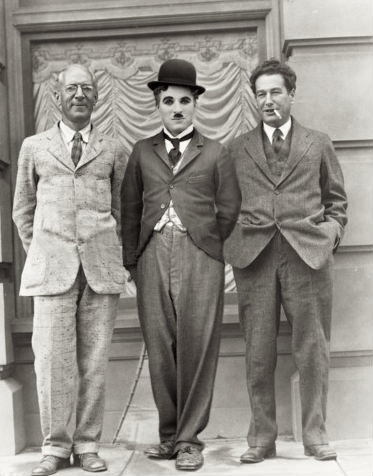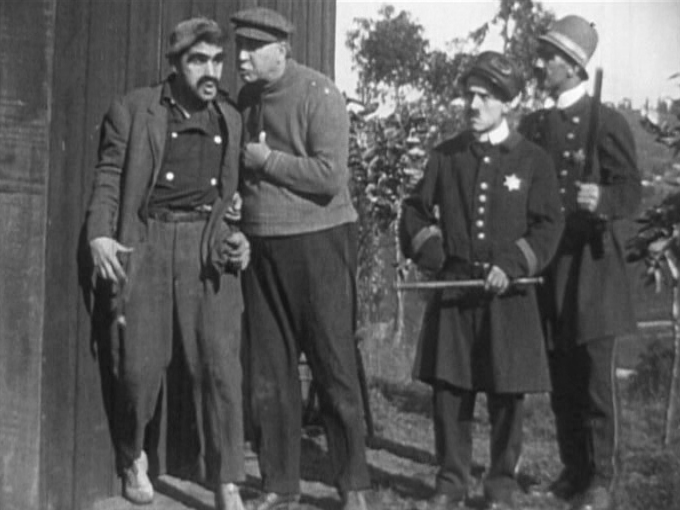

 |
| Composite photograph of Chaplin, Upton Sinclair (left) & Egon Erwin Kisch, 1929 |
"Chaplin? We can stop in on him on the way, if you'd like."
Of course I'd like; he's one of the righteous for whose sake America must be spared the fate of Sodom and Gomorrah.
Another of the righteous is the one who's asking me if we want to stop by Chaplin's place. His name is Upton Sinclair....
Sinclair stops his car at the corner of Longpré Avenue and La Brea Avenue in front of a small group of red-roofed houses. The last thing you'd take from them was a film studio, since film studios in Hollywood are gigantic walled complexes with iron-barred gates and gatekeepers, and with every gable wall plastered with film posters. Here, however, "Chaplin's Studio" is engraved on a tiny metal plaque. We go into an office, that is, to a young woman who alternated between answering the phone and taking care of correspondence. We walk past her into a courtyard that really is a courtyard and where film sets are located. Elsewhere it wouldn't be a courtyard, and if it were it would be called "Stage No. 35," entry would be prohibited, and a watchman would be majestically posted in front of it.
 |
| Plaque on Chaplin Studio door. |
Two men greet Sinclair. There really was a film being shot, they tell him, and one of them says, "The boss is coming!"
The boss! The old man! The chief! We turn around to the boss. To Charlie Chaplin. Were he at least dressed in the appropriate attire of a boss, a chief, the "old man," he could at any other time--when he is not the boss, chief, or "old man"--be that sad vagabond with the comic routines whom we love so much. But now he approaches in the loose-fitting, mended trousers, the patched up oversized shoes, the disarranged necktie, and the worn-out jacket. He is in fact coming from work; he is a boss who works.
"Hello, Upton," he calls from afar. "Good to see you again!" Sinclair says something about the guest he's brought along. "That's fine," replies Charlie Chaplin in the flesh, and we shake hands. He curses; his work isn't moving ahead. He's shooting a new film, City Lights. But "damn it, we've hit another dead end, and can't go on. You want to help me, boys?"
Yes, we boys want to help Charlie Chaplin.
He's not entirely the Charlie Chaplin of the movies. It's true he's coming straight from work, or better said, he's no longer playing a role. His hat, that crushed, melon-shaped little hat, is missing, and so too are the bamboo cane and the small black toothbrush under the nose. Besides, his boots are not so overwhelmingly large and not so overwhelmingly funny as they seem on film; they are misshapen, patched-up, torn, somewhat too big, but still ordinary shoes, and only the art of their boss invested them with their cosmic proportions. Now, rushing to the projection room with us, who are supposed to "help" him, his boots are unobtrusive and the boss is anything but flat-footed. He is wearing horn-rimmed glasses. Without them, he ca't even sign his own name, he's so farsighted.
From his hair two streams of a fountain of silver cascade over the middle of his brow. Even the hair growing on his neck is gray, where it's growing out. ("You ought to have it cut, Charlie," I said to him cautiously a few days later. But he makes no secret of his dyed hair. "You see, I'm not bothering with it anymore. What gets white isn't going to be colored anymore. That's the end of it. At forty, I'll be entirely white again, the way I was at thirty-five.""And what is your wife doing now?""I don't know," he remarks with a gesture of indifference," but I've got two children, and they're both with her.")
Chaplin & Kisch
Now we're in the projection room. While the reel is being loaded, Charlie Chaplin plays the song "Violetara" on the harmonium and sings Spanish words to it that he makes up. Then he invites me to come to his house, where he'll play the organ for me till my eyes and ears give way. "Eh, Jungens?"2
The Jungens confirm, as the boss wishes, that he indeed has a powerful organ at home that he knows how to play in an ear-shattering way, whether his visitor likes it or not.
"I play fantastically well," laughs Chaplin. "But you don't know crap about my music."
The Jungens, who by the way, address the boss as "Charlie," are in fact two men named Harry Crocker and Henry Clive.3 Harry Crocker is a young American with a sweater and a sense of humor. In Circus he played the tightrope dancer in evening dress and Charlie's lucky rival; also the clown that Charlie lathers up and other roles as well. Henry Clive is older, forty-eight, and has a serious career as a magician in American provincial variety shows behind him. The third of the Jungens is calls Heinrich, much like the other two (Harry, Henry), but isn't here today, but that's an exception. We're not going to have any further visit to Chaplin's studio without Mister Henry Bergman sitting, pot-bellied and broad-gauged, in an appropriate chair. At night Bergman-ur4 (as we prefer to call him, since he's a real Magyar) is himself a boss, the owner of a Hollywood Boulevard restaurant for the prominent and those who want to see them. Chaplin made the restauranteur Henry and also endows him with a regular evening visit, for which Bergman-ur returns the favor by visiting Chaplin every day.
Besides the harmonium, a black leather armchair and four wooden easy chairs make up the furnishings of the projection room. Chaplin insists on my taking the armchair, but seems very pleased when I decline. He squats on it with legs folded; it must be his usual place.
And now we're going to let the film roll. For the moment, only a quarter of it is ready, four hundred feet, some of which will be reshot and some cut. The film starts.
I burst out laughing at the place with the watch chain. But someone puts his hand on my knee and tells me to be quiet. Who is it who disputes my natural right to laugh madly at one of Charlie Chaplin's mad moments? It's none other than Charlie Chaplin, and he's sitting right next to me. The film isn't ready yet, and since we're supposed to "help," my laughter is out of place, just as when poor Charlie laughs in Circus when he's supposed to be learning the clown's jokes.
"Terrific," we whisper, after this section of film has been run through and the lights in the projection room come on.
The boss parries: "Can you tell me what you just saw?"
Of course. With pleasure. A girl is selling flowers on a street corner. Then Chaplin comes along....
"Oh, not yet."
First a man comes accompanied by his wife and buys a flower.
"A man? What man?"
A man who looks a little like Adolphe Menjou.
"Yes, an elegant gentleman with a lady. That's important. What else?"
Then Chaplin rounds the corner. He sees a fountain on the wall and takes off his gloves in order to have a drink. That is, not the gloves all at once, but one finger at a time. One finger is missing, and Charlie looks for it without success.
"See, Charlie!" shouts Harry Crocker triumphantly.
"No, it's not clear. "We'll shoot it all over again..."
Now Charlie takes the drinking glass in front of the wall...
"Did you recognize what I represent?"
???
"Am I not this time something different from before?"
Yes, you have a small bow tie and the gloves. This time you want to be a rather foppish tramp, isn't that so? The business with the cup indicates the same thing.
"Would you please explain that too?"
Chaplin takes the cup that's hanging on the chain. As the chain comes to rest on his stomach, Chaplin notices that it would make a splendid watch chain and tries to free it from the wall while he drinks. But he fails and, in resignation, waddles over to the flower girl. She offers...
"Stop, stop. There's something else going on."
Chaplin looks at me piercingly, anxiously, almost imploringly. "There's something else going on."
No, I absolutely can't recall anything else in that scene.
"A car comes, don't you see?"
Yes, a car comes. A man emerges from it and goes over to Chaplin. Chaplin greets him as usual.
"And what is the car doing?"
"I don't know," I confess.
And Upton Sinclair ventures: "I think it's going away."
"Damn, damn," Chaplin mutters, "the whole thing is ruined." His colleagues are also depressed.
I relate what else happens. The girl hands Chaplin a flower, it falls to the ground, both bend over to retrieve it, Chaplin picks the flower up, but the girls continues to look for it despite that fact that he holds it out to her. Then he realizes the girl is blind. He buys the flower and goes on his way.
In order to convince himself that he wasn't wrong, he sneaks back again...
"No, no, he doesn't sneak."
He returns the second time very quickly, as if hurrying by, but draws to a halt while gradually muffling the sound of his steps. Then he turns around, slowly, on tiptoe and sits down next to the girl. But she had just sprinkled the flowers and empties the bucket--right in Chaplin's face. He creeps away and then comes back a third time. And again buys a flower. The blind girl wants to pin it on him and in doing so feels the flower he bought before in his buttonhole. She understands that the man has come back because of her. Chaplin explains to her that his other buttonhole is free, but she insists that a person can't wear flowers in both buttonholes. Then he asks her to keep the flower. She fastens it to her bosom....
"...and..."
...she's in love!
"With whom?"
With Chaplin!
"Damn, damn!"
??
"Doesn't anyone pass by?"
Not that I know.
"Damn, damn! You mean to say you still don't notice a car and a man?"
No
"And you, Upton?"
Didn't notice a thing.
Despairing, Chaplin buries his head in his hands, a picture of abject misery against a black leather background. His colleagues are also sad. But what happened? What are they all so upset over if I, a stranger who just dropped by, doesn't get the gag?
Oh, but it's more than a gag; it's the basic idea of the film that's fallen flat because it's absolutely unclear--my summary means nothing less._________________________________________________________________________________
 |
| Photoplay, July 1918 |
 |
| Mack Swain, Chaplin, and an unidentified actor. |
 |
| Edgar Kennedy & Mack Swain are on the left. |
This is the launch of David Robinson's fabulous new book on Charlie Chaplin, THE WORLD OF LIMELIGHT, published by the Cineteca di Bologna. David Robinson will make a presentation about the Little Tramp and his new finds, and there will be a few other goodies organised by Bryony Dixon of the BFI and Cecilia Cenciarelli of Cineteca di Bologna.Click here for more info.
 |
| Charlie with Professor Einstein and his wife, who were noticeably bewildered by the large crowd. Georgia Hale, Charlie's date, is at far right. |
 |
| Chaplin & Einstein at the premiere. |
 |
| 1931 program for City Lights. |